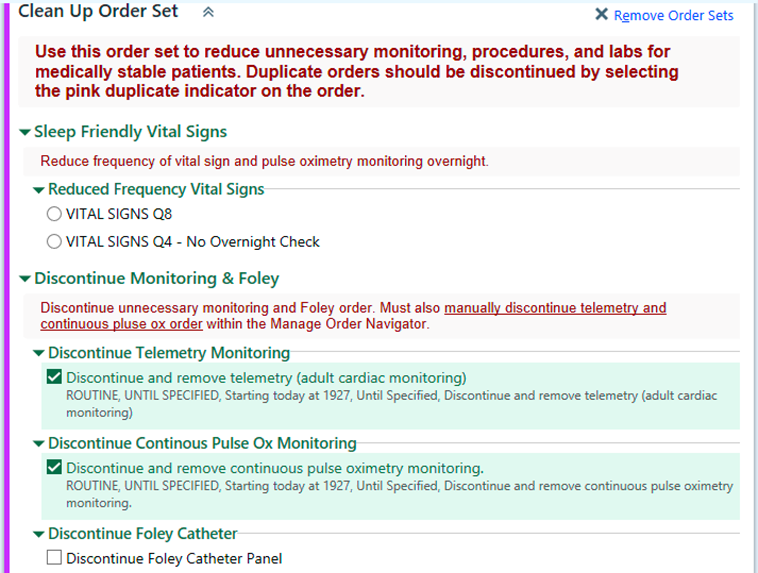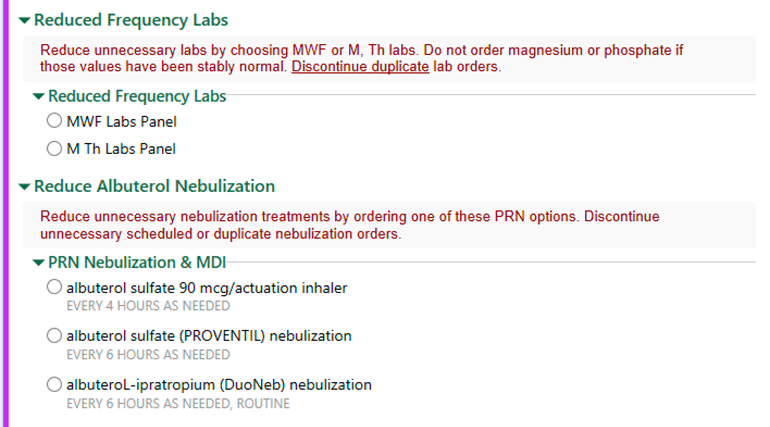Background: Electronic medical records (EMR) often allow automated recurring orders of different components of hospital care, including lab tests, vital signs, and telemetry monitoring. However, as patients clinically stabilize during a hospital admission the frequency and intensity of these recurring orders may be unwarranted (1). Well-designed EMR order sets have shown potential to decrease inappropriate utilization of certain orders in the inpatient setting, such as telemetry (2).
Purpose: Our objective is to develop and evaluate a novel, provider-initiated hospitalist order set that facilitates the review and de-intensification of multiple aspects of recurring hospital care at the same time. The order set will be promoted for use in clinically stable hospitalized patients, such as those pending placement at a facility.
Description: To assess whether wasteful recurring care was a meaningful problem at the University of Chicago Medical Center, baseline data was collected from 4/18/22 to 4/24/22. The primary providers for all 13 hospital medicine services at our medical center were asked daily to identify patients who were “pending placement”, meaning they would be discharged as soon as a facility bed was available. We considered these patients to be medically stable. Over this week, 106 patient-days were spent pending placement, about 10% of total patient-days. Of these, 49% had electrolyte panels ordered at least daily, 51% had complete blood counts (CBC) ordered at least daily, 76% had vital signs ordered every four hours and overnight, and 27% were being monitored with telemetry. Many of these orders had been left unchanged since admission. We then used a combination of literature review and iterative group feedback to decide which care components the order set should address. In addition to electrolyte panels, CBCs, vital signs, and telemetry, our team decided to include Foley catheters, pulse oximetry, and nebulizer treatments. The order set, created by our team’s Epic physician builder, is divided by order type (see figures 1 and 2). Under each order type, one or more low-intensity single-select radio button or checkbox order options are available. For SEPs and CBCs, there are radio button options for Monday-Wednesday-Friday and Monday-Thursday labs. For vital signs, there are options to order vital signs every four or eight hours, excluding overnight checks to promote sleep. For telemetry, Foley catheters, and pulse oximetry, the checkbox order creates a nursing communication requesting discontinuation of the wasteful order. We intend to monitor and promote order set utilization among hospital medicine providers. We will also monitor recurring orders using run charts and perform statistical analysis after several months to assess for pre-post changes in recurring orders.
Conclusions: Wasteful recurring orders are a common problem in stable hospitalized patients, both nationally and at our institution. To confront this, we developed an Epic order set to facilitate evaluation and de-intensification of existing orders for electrolyte panels, CBCs, vital signs, telemetry, Foley catheters, pulse oximetry, and nebulizer treatments. An advantage of this approach is that it allows for a comprehensive, one-time review of recurring hospital care in stable patients.


